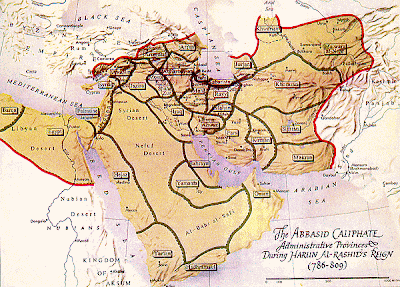 |
| A Byzantine Dromon. The Arab and Byzantine navies battled for centuries across the entire Mediterranean Sea. |
The Sack of Damietta, Egypt - 853 AD
The Arab and Byzantine navies battled for centuries across the entire Mediterranean Sea. There were an endless series of naval battles, invasions, raids and counter raids from the Balearic Islands to Carthage to Sicily to Egypt and Syria.
To a large degree the battles saw a slow advance of Islam and Arab forces. Muslim states were established in Italy, Crete and Cypress. On the other hand, the Roman navy and army often not only held their ground but administered sound defeats on the Muslims both at sea and on land.
Even after many losses to the Arabs, for hundreds of years the Romans kept bouncing back, holding their ground and acted as the shield of Europe against Islamic invasion.
BACKGROUND
In the early 800s the Byzantines has suffered two major defeats. By 827 the island of Crete had fallen to Islamic invaders and was now acting as a base for Arab raids into the Empire. There were multiple unsuccessful attempts by the Byzantines to re-take the island.
From 827 and for more than 70 years the Byzantines were fighting tooth an nail against the Islamic invasion of Sicily. That campaign went on and on for decades in an endless tug of war between Roman and Spanish Muslim and African Muslim troops.
 |
| The Empress Theodora organized the Roman navy and army in multi-front wars against the Arabs, including the sack of Damietta. |
These losses ushered an era where Muslim naval forces raided the Christian northern shores of the Mediterranean almost at will.
THE BYZANTINE EXPEDITION
The Roman Empress Theodora was ruling the Empire as regent for her minor son Michael III. She ran the government with a firm and judicious hand. She replenished the treasury, deterred the Bulgarians from an attempt at invasion and directed military operations against the Arabs on multiple fronts.
In the continuing war with the Arabs, Theodora ordered the building of a new Roman fleet numbering 300 ships. The new naval force was divided into three individual fleets. Two of the fleets may have operated off the coast of Syria or in the Aegean against the Arabs.
A third fleet of 85 vessels and 5,000 troops was sent on a raid to the port of Damietta on the Egyptian coast.
One must assume that the Romans had good intelligence services available to them. Damietta was a major arms supplier to the Muslim forces on Crete which the Romans had been fighting hard to re-capture. Also the Arab governor Anbas had invited the city garrison of Damietta to attend a festival in the far away inland city of Fustat at the exact moment the Roman fleet arrived.
I doubt it was an accident that the Romans attacked at the very moment that the garrison was gone. It would be common knowledge that a festival would be held.
On May 22, 853 the Roman invasion fleet arrived. The people fled the undefended city. For two days the Romans sacked, plundered and finally torched the city. A large quantity of arms and supplies were captured that the Arabs were sending to Crete and 600 Coptic Christian and Arab women were taken back to the ships.
The fleet then sailed eastward down the coast to the island of Tinnis. Fearing sandbanks the fleet moved on to the fortress of Ushtum. The fortress was strongly walled with iron gates. The Romans did not want to engage in a major siege operation so far into enemy territory. So they destroyed what war engines they found outside the city walls and then sailed for home.
The raid was a major victory for the Romans. They had taken the fight deep into enemy territory and had captured or destroyed military supplies that would have been used against them. The Arabs would now have to consider protecting their coastal cities in any future operations against Byzantium.
 |
| The Arab Abbasid Caliphate |
 |
| Map of Eastern Roman and Arab naval battles, raids and invasions. Click on this link for full sized map. |
Source - Bury, John Bagnell (1912). A History of the Eastern Roman Empire from the Fall of Irene to the Accession of Basil I (A.D. 802–867).
No comments:
Post a Comment